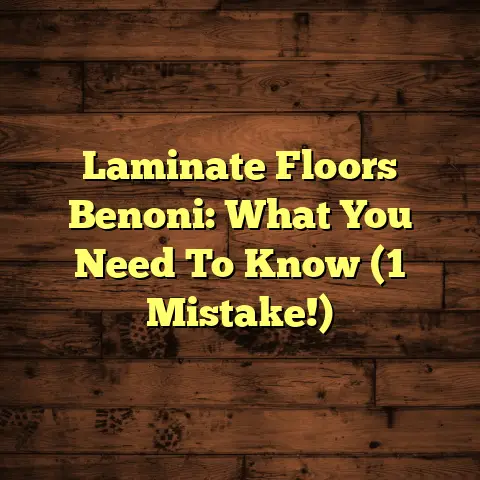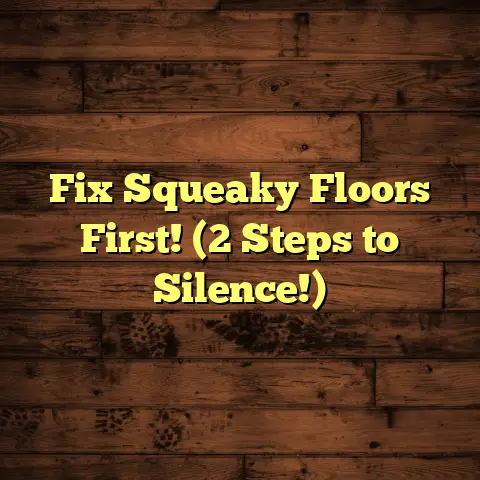How Long Does Floor Insulation Last? (7 Year Warning!)
Remember those winter evenings as a kid?
Curled up by the fireplace, the whole house humming with warmth?
I bet you remember running across the hallway in your socks, that gentle heat rising up from the floorboards.
That feeling, that cozy comfort? A lot of that comes down to something we often forget about: floor insulation.
Homes have changed a ton over the years, but that need for a warm, comfy space? That’s never gone away.
Think back – maybe your grandparents had thick carpets, or draft stoppers at every door.
Those were their ways of battling the cold.
Now, we’ve got much better tech, but it only works if we understand it.
That’s why we need to talk about how long floor insulation really lasts, and why you should pay attention around the 7-year mark.
Section 1: Understanding Floor Insulation
So, what exactly is floor insulation?
Simply put, it’s a material installed under your floors to block heat transfer.
In the winter, it keeps the cold from seeping up; in the summer, it stops heat from rising.
Think of it as a cozy blanket for your house, regulating the temperature and saving you money on energy bills.
There’s a bunch of different types of floor insulation out there.
Let’s break down some of the most common ones:
-
Fiberglass: This is probably the most common, and often the cheapest. It’s made from spun glass fibers and comes in batts or rolls.
It’s good for thermal resistance, but can lose its effectiveness if it gets wet.
-
Foam Boards: These are rigid panels made from materials like polystyrene or polyisocyanurate.
They offer great insulation and are moisture- resistant, making them a solid choice for basements or crawl spaces.
-
Cellulose: This is an eco-friendly option made from recycled paper. It’s treated to be fire-resistant and is blown into place, making it great for filling irregular spaces.
-
Spray Foam: This stuff expands to fill every nook and cranny, creating an airtight seal.
It’s fantastic for insulation and blocking air leaks, but it can be pricier than other options.
The installation process really depends on the type of flooring you have.
For hardwood, you might need to lift the boards to install insulation underneath.
With laminate, you can often lay insulation directly on the subfloor before installing the laminate.
Tile floors are a bit trickier, often requiring a specialized underlayment with insulation properties.
It’s not always a DIY job, and getting it wrong can cause problems down the line.
Section 2: The Lifespan of Floor Insulation
Okay, so how long does this stuff actually last?
That’s the million-dollar question, right?
Generally, most floor insulation can last for 25 years or more.
However, and this is a big however, that depends on a lot of things.
According to the U.S. Department of Energy, well-maintained insulation can last for decades, but regular inspections are key. (Source: energy.gov)
Let’s talk about some of the biggest factors that can shorten the lifespan of your floor insulation:
-
Moisture: This is a killer. If your insulation gets wet, it loses its insulating properties and can become a breeding ground for mold.
I’ve seen basements where the insulation was practically dissolving from dampness.
-
Pests: Mice, rats, and insects love to nest in insulation. They can chew it up, compress it, and leave droppings that reduce its effectiveness.
-
Temperature Fluctuations: Extreme temperature swings can cause the insulation to expand and contract, eventually leading to cracks and gaps.
Here’s a quick rundown of what you might expect:
| Insulation Type | Average Lifespan | Notes |
|---|---|---|
| Fiberglass | 20-30 years | Can degrade faster if exposed to moisture or pests. |
| Foam Boards | 50-80 years | Highly durable and moisture-resistant, but can be damaged by UV exposure if not properly covered. |
| Cellulose | 20-30 years | Effective, but can settle over time, reducing its R-value. |
| Spray Foam | 80+ years | Long-lasting and airtight, but can be expensive to install. |
Keep in mind, these are just averages.
Regular inspection and maintenance can extend the life of your insulation, while neglect can shorten it considerably.
Section 3: The 7-Year Warning
Alright, let’s get to the heart of the matter: the 7-year warning.
Why seven years?
Well, from my experience, around the 7-year mark, you start to see subtle signs that your insulation might be losing its oomph.
It’s not a hard and fast rule, but it’s a good time to start paying close attention.
Here are some red flags to watch out for:
-
Increased Energy Bills: This is the big one. If you notice your heating or cooling costs creeping up, even though your usage hasn’t changed, it could be a sign that your insulation isn’t doing its job.
-
Drafts: Feeling cold drafts near the floor, especially along exterior walls? That’s a classic sign of failing insulation.
-
Uneven Floor Temperatures: Some areas of your floor feel noticeably colder than others? That could mean the insulation is compressed, damaged, or missing in those spots.
-
Moisture or Mold: Any signs of dampness, water stains, or mold growth near the floor are a major concern. This can indicate a leak or condensation problem that’s damaging your insulation.
Let me tell you about a client of mine, Sarah.
About eight years after she bought her house, she started noticing her energy bills were climbing.
She brushed it off at first, thinking it was just the rising cost of energy.
But then she started feeling drafts near the floor in her living room.
I came out and did an inspection, and sure enough, the floor insulation in her crawl space was waterlogged and moldy.
Turns out, a small leak in her foundation had been slowly soaking the insulation for years.
Because she ignored the early warning signs, she ended up having to replace a large section of her flooring and the entire insulation system.
Ignoring these signs can lead to bigger problems, like structural damage, mold infestations, and sky-high energy bills.
Section 4: The Importance of Regular Inspections
So, how do you avoid Sarah’s fate?
Regular inspections are key.
I recommend checking your floor insulation at least once a year, preferably in the spring or fall.
Here’s a checklist to get you started:
-
Visual Inspection: Look for any signs of damage, like tears, compression, or discoloration.
-
Moisture Check: Feel the insulation for dampness. If it feels wet, investigate the source of the moisture.
-
Pest Check: Look for signs of rodents or insects, like droppings, nests, or chewed insulation.
-
Air Leak Test: On a cold day, hold your hand near the floor along exterior walls.
Can you feel any drafts?
-
Temperature Check: Use a thermometer to check the temperature of different areas of your floor. Are there any significant differences?
Seasonal changes can have a big impact on your insulation.
In the winter, cold temperatures can exacerbate any existing problems, making drafts more noticeable.
In the summer, humidity can lead to moisture buildup, especially in basements and crawl spaces.
Spring and fall are ideal times for inspections because the weather is usually milder, making it easier to access and inspect your insulation.
Plus, you can catch any problems before they become severe during the extreme temperatures of summer and winter.
Section 5: The Environmental Impact of Old Insulation
Let’s talk about something that’s easy to overlook: the environmental impact of old or damaged floor insulation.
It’s not just about your comfort and your wallet; it’s also about the planet.
When your insulation isn’t working properly, your home becomes less energy-efficient.
This means your heating and cooling systems have to work harder to maintain a comfortable temperature, which leads to increased energy consumption.
And where does that energy come from?
Often, it comes from fossil fuels, which release greenhouse gases into the atmosphere and contribute to climate change.
According to the EPA, buildings account for nearly 40% of U.S. energy consumption. (Source: epa.gov)
That’s a huge number, and a significant portion of that energy is wasted due to poor insulation.
But here’s the good news: there are sustainable insulation options available that not only last longer but are also eco-friendly.
-
Recycled Denim Insulation: Made from recycled jeans, this insulation is a great way to reduce waste and improve your home’s energy efficiency.
-
Sheep’s Wool Insulation: A natural and renewable resource, sheep’s wool insulation is excellent at regulating moisture and temperature.
-
Plant-Based Insulation: Made from materials like hemp or flax, these insulation options are sustainable and biodegradable.
By choosing sustainable insulation, you can reduce your carbon footprint and help create a healthier planet.
It’s a win-win.
Section 6: Conclusion
So, let’s recap.
Understanding the lifespan of your floor insulation and paying attention to the 7-year warning is crucial for maintaining a comfortable, energy-efficient home.
Ignoring the signs of failing insulation can lead to higher energy bills, structural damage, and environmental consequences.
Remember that cozy feeling of stepping onto a warm floor on a cold winter evening?
That’s the peace of mind that comes from knowing your home is well-insulated.
Maintaining our homes is about more than just keeping them in good repair.
It’s about ensuring that they remain places of comfort, joy, and security for future generations, just as they were for us.
So, take the time to inspect your floor insulation, address any issues promptly, and choose sustainable options when possible.
Your home, your wallet, and the planet will thank you for it.





